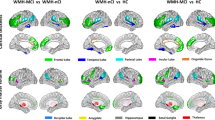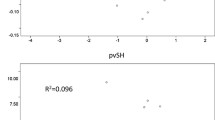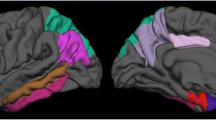Abstract
We have previously shown that the minicolumnar spacing of neurons in the cerebral cortex relates to cognitive ability, and that minicolumn thinning occurs in old age. The present study examines further the relationship between cognitive ability and cortical fine structure (minicolumn organization and neuropathology) in the dorsolateral prefrontal cortex (dlPFC) and the parahippocampal gyrus (PHG) in mild cognitive impairment (MCI) and Alzheimer’s disease (AD). Premortem neuropsychological scores were related to postmortem microanatomy in 58 adults (20 normal controls, 18 MCI, and 20 confirmed AD patients). We found a correspondence between minicolumn thinning in the dlPFC and IQ decline in dementia. In mild impairment, IQ remained stable, as did dlPFC minicolumn width and dlPFC plaque load. IQ only declined as dlPFC minicolumn thinning occurred and dlPFC plaque load increased in more severe dementia. By contrast, plaque load increased and minicolumns became steadily thinner in the PHG, where minicolumn width correlated with declining mini-mental state examination score across both MCI and severe dementia. By including a further 14 younger control subjects, we found that in normal healthy aging, minicolumn width decreased in the dlPFC, whereas PHG minicolumn width did not change. AD patients in our dataset with higher IQ were older at time of death and had less pathology, which supports a neural basis for the cognitive reserve hypothesis.







Similar content being viewed by others
References
Anstey KJ, Low LF (2004) Normal cognitive changes in aging. Aust Fam Phys 33:783–787
Armstrong RA (2009) The molecular biology of senile plaques and neurofibrillary tangles in Alzheimer’s disease. Folia Neuropathol 47:289–299
Benes FM, Turtle M, Khan Y, Farol P (1994) Myelination of a key relay zone in the hippocampal formation occurs in the human brain during childhood, adolescence, and adulthood. Arch Gen Psychiatry 51:477–484
Brans RB, Kahn RS, Schnack HG, Van Baal GC, Posthuma D, Van Haren NE, Lepage C, Lerch JP, Collins DL, Evans AC, Boomsma DI, Hulshoff Pol HE (2010) Brain plasticity and intellectual ability are influenced by shared genes. J Neurosci 30:5519–5524
Buxhoeveden DP, Switala AE, Roy E, Casanova MF (2000) Quantitative analysis of cell columns in the cerebral cortex. J Neurosci Methods 97:7–17
Cabeza R (2002) Hemispheric asymmetry reduction in older adults: the HAROLD model. Psychol Aging 17(1):85–100
Cabeza R, Anderson ND, Locantore JK, McIntosh AR (2002) Aging gracefully: compensatory brain activity in high-performing older adults. Neuroimage 17:1394–1402
Casanova MF, Switala AE (2005) Minicolumnar morphometry: computerized image analysis. In: Casanova MF (ed) Neocortical modularity and the cell minicolumn. Nova Biomedical, New York, pp 161–180
Chance SA, Tzotzoli PM, Vitelli A, Esiri MM, Crow TJ (2004) The cytoarchitecture of sulcal folding in Heschl’s sulcus and the temporal cortex in the normal brain and schizophrenia: lamina thickness and cell density. Neurosci Lett 367:384–388
Chance SA, Casanova MF, Switala AE, Crow TJ (2006a) Minicolumnar structure in Heschl’s gyrus and planum temporale: asymmetries in relation to sex and callosal fiber number. Neuroscience 143:1041–1050
Chance SA, Casanova MF, Switala AE, Crow TJ, Esiri MM (2006b) Minicolumn thinning in temporal lobe association cortex but not primary auditory cortex in normal human ageing. Acta Neuropathol 111:459–464
Chance SA, Clover L, Cousijn H, Currah L, Pettingill R, Esiri MM (2011) Microanatomical correlates of cognitive ability and decline: normal ageing, MCI, and Alzheimer’s disease. Cereb Cortex 21:1870–1878
Cruz L, Roe DL, Urbanc B, Inglis A, Stanley HE, Rosene DL (2009) Age-related reduction in microcolumnar structure correlates with cognitive decline in ventral but not dorsal area 46 of the rhesus monkey. Neuroscience 158:1509–1520
Cummings JL (2004) Treatment of Alzheimer’s disease: current and future therapeutic approaches. Rev Neurol Dis 1:60–69
Di Rosa E, Crow TJ, Walker MA, Black G, Chance SA (2009) Reduced neuron density, enlarged minicolumn spacing and altered ageing effects in fusiform cortex in schizophrenia. Psychiatry Res 166:102–115
Dowling NM, Tomaszewski Farias S, Reed BR, Sonnen JA, Strauss ME, Schneider JA, Bennett DA, Mungas D (2011) Neuropathological associates of multiple cognitive functions in two community-based cohorts of older adults. J Int Neuropsychol Soc 17:602–614
Echávarri C, Aalten P, Uylings HB, Jacobs HI, Visser PJ, Gronenschild EH, Verhey FR, Burgmans S (2011) Atrophy in the parahippocampal gyrus as an early biomarker of Alzheimer’s disease. Brain Struct Funct 215:265–271
Ehninger D, Kempermann G (2008) Neurogenesis in the adult hippocampus. Cell Tissue Res 331:243–250
Geary DC (2005) The origin of mind: evolution of brain, cognition, and general intelligence. American Psychological Association, Washington
Giedd JN, Blumenthal J, Jeffries NO, Castellanos FX, Liu H, Zijdenbos A, Paus T, Evans AC, Rapoport JL (1999a) Brain development during childhood and adolescence: a longitudinal MRI study. Nat Neurosci 2:861–863
Giedd JN, Blumenthal J, Jeffries NO, Castellanos FX, Liu H, Zijdenbos A, Paus T, Evans AC, Rapoport JL (1999b) Brain development during childhood and adolescence: a longitudinal MRI study. Nat Neurosci 10:861–863
Glisky EL (2007) Changes in cognitive function in human aging. In: Riddle DR (ed) Brain aging. Models, methods, and mechanisms. CRC Press, Boca Raton, pp 3–20
Goh JOS (2011) Functional dedifferentiation and altered connectivity in older adults: neural accounts of cognitive aging. Aging Dis 2(1):30–48
Gray JR, Chabris CF, Braver TS (2003) Neural mechanisms of general fluid intelligence. Nat Neurosci 6:316–322
Horn JL, Cattell RB (1967) Age differences in fluid and crystallized intelligence. Acta Psychol 26:107–129
Ince PG (2001) Pathological correlates of late-onset dementia in a multicenter community-based population in England and Wales. Lancet 357(9251):169–175
Jung-Beeman M (2005) Bilateral brain processes for comprehending natural language. Trends Cognit Sci 9:512–518
Kane MJ, Engle RW (2002) The role of prefrontal cortex in working-memory capacity, executive attention, and general fluid intelligence: an individual-differences perspective. Psychon Bull Rev 9:637–671
Lindenberger U, Baltes PB (1994) Sensory functioning and intelligence in old age: a strong connection. Psychol Aging 9:339–355
Matheson J (2010) The UK population: how does it compare? Popul Trends 142:6–29
McDonald B, Highley JR, Walker MA, Herron BM, Cooper SJ, Esiri MM, Crow TJ (2000) Anomalous asymmetry of fusiform and parahippocampal gyrus gray matter in schizophrenia: a postmortem study. Am J Psychiatry 157:40–47
McGurn B, Starr JM, Topfer JA, Pattie A, Whiteman MC, Lemmon HA, Whalley LJ, Deary IJ (2004) Pronunciation of irregular words is preserved in dementia, validating premorbid IQ estimation. Neurology 62:1184–1186
Motulsky H, Christopoulos A (2005) Fitting models to biological data using linear and nonlinear regression: a practical guide to curve fitting. Graphpad Software, Inc., San Diego
Peters A (2010) The morphology of minicolumns. In: Blatt GJ (ed) The neurochemical basis of Autism. Springer, New York, pp 45–68
Piefke M, Onur OA, Fink GR (2010) Aging-related changes of neural mechanisms underlying visual-spatial working memory. Neurobiol Aging [Epub ahead of print]
Rabbitt P, Lowe C (2000) Patterns of cognitive ageing. Psychol Res 63:308–316
Rakic P (1995) A small step for the cell, a giant leap for mankind: a hypothesis of neocortical expansion during evolution. Trends Neurosci 18:383–388
Raz N, Lindenberger U, Ghisletta P, Rodrigue KM, Kennedy KM, Acker JD (2008) Neuroanatomical correlates of fluid intelligence in healthy adults and persons with vascular risk factors. Cereb Cortex 18:718–726
Shankar SK (2010) Biology of aging brain. Indian J Pathol Microbiol 53:595–604
Steinerman JR (2010) Minding the aging brain: technology-enabled cognitive training for healthy elders. Curr Neurol Neurosci Rep 10:374–380
Stern Y (2009) Cognitive reserve. Neuropsychologia 47:2015–2028
Tucker AM, Stern Y (2011) Cognitive reserve in aging. Curr Alzheimer Res [Epub ahead of print]
Voytek B, Davis M, Yago E, Barceló F, Vogel EK, Knight RT (2010) Dynamic neuroplasticity after human prefrontal cortex damage. Neuron 68:401–408
Wenk GL (2003) Neuropathologic changes in Alzheimer’s disease. J Clin Psychiatry 64:7–10
Zatorre RJ, Belin P (2001) Spectral and temporal processing in human auditory cortex. Cereb Cortex 11:946–953
Acknowledgments
The authors would like to thank the researchers from OPTIMA for providing the neuropsychological test scores and subject information used in this study. Furthermore we would like to thank the families of the donors for making studies such as this possible, acquiring more knowledge into the neurobiology of aging and dementia. This work was supported by a fellowship from Alzheimer Scotland, UK (to S.A.C.).
Conflict of interest
There are no declared conflicts of interest.
Author information
Authors and Affiliations
Corresponding author
Rights and permissions
About this article
Cite this article
van Veluw, S.J., Sawyer, E.K., Clover, L. et al. Prefrontal cortex cytoarchitecture in normal aging and Alzheimer’s disease: a relationship with IQ. Brain Struct Funct 217, 797–808 (2012). https://doi.org/10.1007/s00429-012-0381-x
Received:
Accepted:
Published:
Issue Date:
DOI: https://doi.org/10.1007/s00429-012-0381-x




